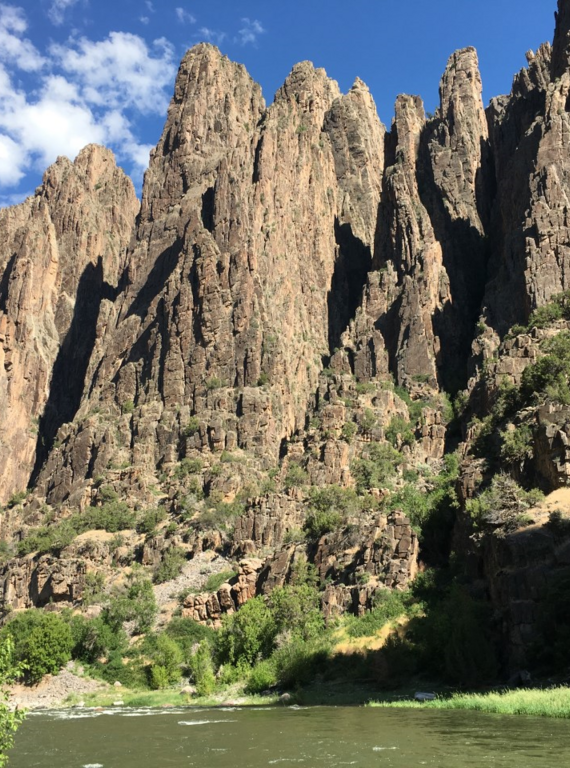The South Rim Fire at Black Canyon of the Gunnison National Park continues to burn. Here’s what we know.
For the first time in its more than 90-year history as a national park site, Colorado’s Black Canyon of the Gunnison was entirely closed because of wildfire this month, and campground reservations have been canceled for the rest of the year. Although a portion of the park is slated to reopen July 30, the most heavily used part of the park — the South Rim — has been damaged to the point where many areas are either no longer there or look completely different.
A fire that began July 10 due to multiple lightning strikes on both sides of the park had exceeded 4,200 acres and was just over 40% contained as of July 28. That area accounts for 12% of the entire national park, but about 80% of South Rim. Unfortunately, the South Rim Fire, as it has been named by responders, is one of five in the region, and a sixth flared up Sunday near the South Rim Fire, forcing the closure of U.S. Highway 50 near a local town.

Updates
As of Aug. 4, the South Rim Fire had been 52% contained. The National Park Service reopened the North Rim of Black Canyon of the Gunnison to visitors July 30,…
See more ›Black Canyon of the Gunnison is located in the west-central part of Colorado and contains some of the steepest cliffs and oldest rock visible on our planet — some nearly half the age of the Earth itself. The Ute Indian Tribe of the Uintah and Ouray Reservation, Ute Mountain Ute Tribe, and the Southern Ute Indian Tribe are among the sovereign nations that first stewarded this landscape and remain closely tied to it. The park was established as a national monument in 1933 and became a national park in 1999.
I remember my jaw dropping the first time I found this place while on a long road trip through the Western Slope before calling Colorado my forever home. It felt like I was discovering a new brain pathway — those cliffs, the pockets of darkness, the enormity of this landscape that seemed to come out of nowhere. I’m still humbled by this space every time I return. And while it’s a public park that belongs to all of us, I still feel a sense of personal pride when someone sends me a text about how amazing their trip out to the park was and how stunning they find it.
More than half of the park is designated wilderness, bookended by two gateway communities and surrounded by public lands managed by other federal agencies. Known for its 2,000-foot-deep, 48-mile canyon formed by the Gunnison River, a major tributary of the Colorado River, the park also hosts old growth forests and meadows. The terrain that is burning is covered with sagebrush, grassland, and pinyon pine and juniper trees. Some of the trees are over 700 years old.
My heart hurts for these trees, and I find myself imagining the desperate terror that so many animals must have felt as the disaster quickly consumed so much of their home. Black Canyon is a haven for nearly 260 animal species, including precious black bear, the endangered Gunnison sage grouse, yellow bellied marmots, bighorn sheep, mule deer, mountain lion, bobcat and rare owls.
The South Rim Fire occurred as the Dragon Bravo Fire consumed the North Rim of Grand Canyon National Park. It’s devastating to think that climate change is tied to the increasing frequency and intensity of wildfires, which damage park infrastructure and habitat. Wildfire seasons have expanded and fires have increased in frequency and size, especially in the western United States.
The park’s total estimated loss won’t be known until after the fire is contained, but the recovery process likely will be extensive. Among known losses are a 3,456-square-foot maintenance building, the Western National Parks warehouse containing materials the park relies on to provide visitors with an informed experience, including approximately $80,000 worth of park brochures; a welding shop; a hazardous materials building; a lumber shed; several pieces of heavy equipment; and the majority of the South Rim bathroom areas and campgrounds, all of which have burned to the ground. Shade shelters and overlooks also were heavily damaged.
Thankfully, park staff and all visitors were safely evacuated, as were some residents of nearby communities.
In just two days, the fire nearly doubled in size as a result of gusty winds, low humidity and severe drought. Park staff living in the South Rim and East Portal areas had to be relocated to housing at Curecanti National Recreation Area and areas further away. Water in Curecanti’s Blue Mesa Reservoir proved critical to firefighting aircraft used in fighting the South Rim fire.

What We’ve Lost on the Grand Canyon’s North Rim
Places like Grand Canyon Lodge aren’t just buildings. They hold pieces of our collective stories, where generations have gathered.
See more ›The fire is yet another catastrophic event for the park this year. Because of federal workforce directives by Trump administration, Black Canyon of the Gunnison’ staff size has been reduced by one-third. Twenty-four of the parks’ 74 positions are unfilled and will remain unfilled while the hiring freeze continues. With all custodial staff gone, higher graded maintenance employees were being directed away from their regular duties to perform custodial functions. The park’s employees who specialize in aquatic invasive species were also helping with the cleaning of restrooms. These are just some examples of many and don’t include the extreme stress and rock-bottom morale our federal workforce continues to experience. The fire adds more stress and heartbreak to the park’s already stretched workforce.
The park’s closure will surely impact the region’s economy, especially the gateway communities of Gunnison and Montrose. In 2024, Black Canyon and Curecanti welcomed more than 1.3 million recreation visits, with visitors spending an estimated $25.6 million in local communities while visiting Black Canyon alone.

Black Canyon of the Gunnison National Park is known for its craggy canyon walls that loom above the Gunnison River.
NPSPeople come to Black Canyon of the Gunnison for the hiking, fishing, kayaking and rock climbing, as well as for the inspiration: the wildlife watching, epic views of the San Juan and West Elk mountains and the Uncompaghre Valley, proximity to Curecanti National Recreation Area, and the rare, certified dark skies. They also come to learn from park rangers, ecologists and other park staff who need our support now more than ever.
What will happen to this park, and other surrounding public lands, after the wildfire fully sweeps through? What will the park experience be for future generations?
We can’t know for sure right now, but we do know that national parks and their staff are hurting like never before and that we, along with congressional leaders like U.S. Rep. Jeff Hurd whose district is home to Black Canyon, need to stand strong with them now, into the recovery process and beyond.
Stay On Top of News
Our email newsletter shares the latest on parks.
About the author
-
 Tracy Coppola Colorado Senior Program Manager, Southwest
Tracy Coppola Colorado Senior Program Manager, SouthwestTracy Coppola is based in Denver and serves as the Colorado Senior Program Manager for the Southwest Regional Office. She is proud to have the opportunity to celebrate her state's incredible parks and advocates.
-
General
-
- NPCA Region:
- Southwest
-
Issues


